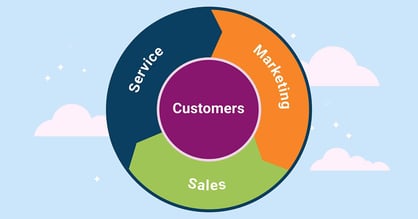We hear a common frustration over and over again: leads driven by inbound marketing often sit, wasting away in the depths of your CRM, never making it down funnel to an eagerly-waiting sales team.
Or worse, ALL of the inbound leads are passed to sales and are quickly abandoned when the sales team realizes that converting those leads takes too much time away from activities that yield a higher sales return.
Even companies using tools like HubSpot, a platform designed to centralize and streamline the sales and marketing process, often share this same complaint. And for companies dealing in a complex sale, this waste can translate to hundreds of thousands of dollars, if not millions, lost.
Here’s the truth: if your product or service is sold to a sophisticated buyer, which means you probably have a highly compensated sales team, you have to be strategic in your efforts to manage the lead funnel. You need both inbound and outbound activities to succeed. And technology used the right way can help synchronize these efforts for maximum results.
Sales development has never been easy, but it has gotten a lot harder in recent years, requiring more touch points and highly-personalized outreach to move leads from the marketing funnel over to the sales pipeline. But it’s not impossible. An outbound marketing strategy, applied at the very top of the funnel, lets you build a qualified audience so that your marketing activity is aimed at the right buyers from the beginning.
As a HubSpot Agency Partner, we’ve uncovered some unique ways to use the platform to help drive a winning sales development strategy and really achieve the sales and marketing alignment you’ve been aiming for.
HubSpot is built for inbound marketing, and their Lifecycle Stages map to the process they’ve found best for working those leads. But since every company is unique — with different markets and target audiences for different offerings — we suggest a roadmap to combine some of HubSpot’s Lifecycle Stages with Lead Status Indicators to clearly define and prioritize your unique lead funnel.
At MarketLauncher we have found that most of our clients can best optimize their lead funnel by further defining MQL (Marketing Qualified Lead) and SQL (Sales Qualified Lead) with a Lead Status. By more clearly defining MQLs and SQLs, your team can prioritize follow-up at two critical points in the lead development process. This prioritization will ultimately result in a higher return on investment.
Let’s start with MQL. Not all MQLs are created equal. Using an inbound and outbound process, we define MQLs as either INBOUND leads or VERIFIED OUTBOUND leads who have REACTED to an email. These are bucketed using Verified and NOT Verified Lead Statuses.
MQL-Verified
These are inbound leads who have been verified as the right decision maker at a company that meets the customer profile. These would be highest priority for follow-up.
These can also be contacts who have been verified with outbound calling as the right decision maker at a company that meets the customer profile, and through proactive outreach they have reacted (Open/Clicked) to content.
MQL-Not Verified
These are inbound leads who have not been verified as the right decision maker at a company that meets the customer profile. These need outbound to confirm they are verified as the right decision maker.
Next let’s discuss SQLs. Like MQLs, not all SQLs are created equal. We define SQL as a verified contact that has been reached - either by phone or email. And then for Lead Status, we further define SQL with these three Lead Statuses:
SQL - Engaged Current
These are decision makers likely to convert in the next 30 days - they are engaged and the timing is right. This is where the Sales team needs to focus the most time and attention.
SQL - Engaged Future
These are decision makers who are engaged and likely to convert - IN THE FUTURE. The timing is not right now. Clearly defined follow-up from Sales is needed when the time is right.
SQL - Nurture
These are decision makers who are not interested now, however a consistent nurture program should be put in place. It should consist of calls and emails from Sales to keep your company top of mind when timing and needs align.
Here’s the bottom line: For improved marketing and sales alignment, clearly defined Lead Statuses like the above are needed for MQL and SQL Lifecycle Stages. For MQLs, the Lead Status allows the verified contacts to get the most time and attention to convert them to SQLs.
For SQLs, the Lead status helps to truly see what the market is saying and how the campaign is performing as well as what is in the lead funnel to advance - now and in the future. It is this level of alignment and visibility between marketing and sales that is key for a predictable growth business model.
If you’re only using HubSpot to engage with and track inbound leads, you’re missing out on a big chunk of your potential audience.
An outbound marketing strategy lets you identify your total addressable market, meaning all those companies and decision makers who could be a fit for your product or service. Audience development helps you proactively find the right contacts so you’re starting with a strong list of people to target right from the very beginning.
Outbound calling is essential to maintain the quality of your list. Do you know if all the contact information on your list is up-to-date? No matter how good you think your list is, contact information goes out of date very quickly, sometimes within months.
If you’re using a list within HubSpot to fuel your pipeline, you’ll get a much lower return on your investment if your list isn’t fully up to date. Even with outstanding content, if you’re not talking to the right people, they will never move into your sales pipeline. Quality contacts are key, and outbound is the best way to confirm.
Within HubSpot, sales teams can work smarter and make better decisions based on real-time data. It’s easy to see what messaging and outreach is working and how you can make changes to optimize your sales campaigns.
HubSpot also makes it much easier to keep up with contact information changes, like when a lead moves on to a new company. The data is in a centralized location, so everyone has access to it, and it’s simple to update and track.
Having qualified leads makes all the difference for sales development. Just clicking a link or filling out a form doesn’t make a lead sales-ready. To move them through the pipeline, they have to be verified and require repeated personal touches. HubSpot workflows and reporting streamline that process.
Within HubSpot, you can track several crucial metrics to qualify leads and evaluate when they are ready to move down funnel. These are the key metrics to keep an eye on to optimize your outreach:
How many emails has a lead opened? Have they clicked any links? This data lets you identify the very best contacts, the most engaged ones, so you can focus your efforts on moving these high-value leads down funnel. Have they opened three emails in the past week? That information should inform your outbound calling strategy, leading you to get in touch with the warmest leads first.
How successful is your outbound calling? Are you making meaningful connections, or leaving lots of unanswered voice mails? Your outbound calling performance is an indication of the quality of leads you’re contacting. If it takes a lot of touches to reach someone, they probably are not yet ready to talk to sales. It might be time to go back to sending them personalized content to keep building touchpoints until they’re ready to move to a direct conversation.
Setting up dashboards in HubSpot lets you conveniently watch these metrics and check in on email performance and sequence rates. Access to this data in real time lets you see what’s working or not as far as content and direct outreach so you can easily adjust your campaigns and make better decisions.
Another helpful feature is the ability to make customized, filtered lists to organize leads. You can also create saved filters within contacts to identify hot versus cold leads so sales development specialists can focus their outreach on those who are engaging in a timely manner.
HubSpot sales sequencing is a game-changer for your sales team. Sales sequencing makes the sales development process feel less lengthy, tiring, and unforgiving by automating tasks and making follow-up a natural part of your sales development process.
For the past ten years, our team has used a 1-2-3 email sequence, interspersed with calling, to move leads down funnel. Much of this process was manual. Within HubSpot, our sales development specialists can now turn this time-tested process into a sales sequence. They no longer have to repeatedly type out those same emails or keep tabs on when to initiate a follow-up call.
Say you want to get in touch with a lead after they open email number two. Sales specialists can set up HubSpot to automatically alert them the moment a contact opens that second email, allowing them to maintain highly synchronized follow-up.
Scheduling emails in advance, having them send based on a lead’s actions, and getting reminders about when to schedule phone calls lets the sales team spend less time on manual tasks and more time working on booking meetings with qualified leads.
Another game-changer is HubSpot’s detailed analytics into the success of your sales outreach. The metrics let you see what emails and what sequencing are working best to drive engagement. If one member of your sales team is seeing huge results, your whole sales team can benefit by adopting their process, clearly laid out in HubSpot and easy to replicate.
Marketing and sales teams have different skill sets. They’re distinct departments for a reason. The trick to bringing those skills together is having a clearly defined sales development process.
HubSpot makes that easier by giving both teams full visibility into the sales process and automating sales development tasks.
Want to make better use of the HubSpot sales process? We’ve got a time-tested method that’s driven proven results. Find out more about our process in our sample report or let's schedule a time to talk.




